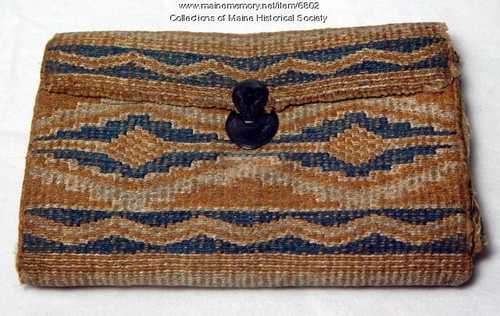Keywords: Abenaki
Item 9213
Derivations of the name Peter Paul within the Abenaki community, 1960
Contributed by: Maine Historical Society Date: 1960-06-13 Location: Woodstock Media: Ink on paper
Item 14426
Bell-shaped Sewing Basket, ca. 1981
Contributed by: Abbe Museum Date: circa 1981 Location: Odanak Media: Ash, sweetgrass
Exhibit
When Europeans arrived in North America and disrupted traditional Native American patterns of life, they also offered other opportunities: trade goods for furs. The fur trade had mixed results for the Wabanaki.
Exhibit
Father Rasles, the Indians and the English
Father Sebastien Rasle, a French Jesuit, ran a mission for Indians at Norridgewock and, many English settlers believed, encouraged Indian resistance to English settlement. He was killed in a raid on the mission in 1724 that resulted in the remaining Indians fleeing for Canada.
Site Page
Skowhegan Community History - Abenakis in the Norridgewock/Skowhegan Area
"The Abenakis believed that the lands were there to share, and to hunt on, as needed to live but the English wanted to own it and keep anyone off that…"
Site Page
Historic Hallowell - Meeting at Koussinok
"… harvests, hoping to establish trade with the Abenaki people. About 40 miles from the ocean, when they reached the last point of navigation on the…"
Story
Mali Agat (Molly Ockett) the famous Wabanaki "Doctress"
by Maine Historical Society
Pigwacket Molly Ockett, healing, and cultural ecological knowledge
Story
Wabanaki Sovereignty
by Mali Obomsawin and Lokotah Sanborn
Bomazeen Land Trust, renewing and resuming Wabanaki caretaking and stewardship roles
Lesson Plan
Nation to Nation: Treaties and Legislation between the Wabanaki Nations and the State of Maine
Grade Level: 9-12
Content Area: Social Studies
This lesson plan asks high school students to think critically about and look closely at documentation regarding the Nation-to-Nation relationship between the Wabanaki Tribes/Nations and the State of Maine. This lesson asks students to participate in discussions about morality and legislative actions over time. Students will gain experience examining and responding to primary and secondary sources by taking a close look at documents relating to the Maine Indian Claims Settlement Act of 1980 (MICSA) and the issues that preceded and have followed the Act.
Lesson Plan
Grade Level: 3-5, 6-8, 9-12
Content Area: Science & Engineering, Social Studies
This lesson plan will give middle and high school students a broad overview of the ash tree population in North America, the Emerald Ash Borer (EAB) threatening it, and the importance of the ash tree to the Wabanaki people in Maine. Students will look at Wabanaki oral histories as well as the geological/glacial beginnings of the region we now know as Maine for a general understanding of how the ash tree came to be a significant part of Wabanaki cultural history and environmental history in Maine. Students will compare national measures to combat the EAB to the Wabanaki-led Ash Task Force’s approaches in Maine, will discuss the benefits and challenges of biological control of invasive species, the concept of climigration, the concepts of Traditional Ecological Knowledge (TEK) and Indigenous Knowledge (IK) and how research scientists arrive at best practices for aiding the environment.
















